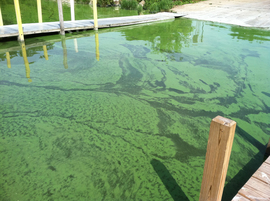 As temperatures rise this summer, people
turn to local beaches and lakes as a fun way to cool off. However, recent toxic
algal blooms have hindered this experience for some in places like Florida, California, New York,
and Vermont.
Algae are vitally important to
marine and fresh-water ecosystems, and most species of algae are not harmful.
However, according to the Centers
for Disease Control and Prevention, a harmful algal bloom (HAB) can occur
when certain types of microscopic algae grow quickly in water, forming visible
patches that may harm the health of the environment, plants, or animals. HABs
can deplete the oxygen and block the sunlight that other organisms need to
live, and some HAB-causing algae release toxins that are dangerous to animals
and humans.
Less than one percent of algal
blooms are toxic. However, not only is it unsafe to swim when toxic blooms are
present, but toxic algal blooms are a growing environmental health concern.
Nutrient runoff into lakes, streams and
other bodies of water can cause algal blooms. NIFA is working to monitor
and mitigate the effects of excess nutrients and prevent its occurrence in the
first place.
One example is NIFA’s support of
the National
Atmospheric Deposition Program, which tracks how airborne nitrogen is
deposited in the U.S. and contributes to the dead zone in the Gulf of Mexico. The
agency provides $500,000 in funding for state agricultural experiment station
research and coordinates $1.8 million per year of interagency funding in
support of the program.
Using cover crops can mitigate nutrient
discharge into watersheds and significantly reduce soil erosion across the
state. A team of NIFA-funded researchers from Ohio State University implemented
ECO Farming, a natural
and sustainable production system, to reduce nutrient runoff. Using continuous
living cover crops, farmers were able to prevent soil erosion, increase water
filtration and decrease nutrient runoff. This method uses a crop production
system that mimics natural cycles in soil feeds, the microbes which recycle
nitrogen, phosphorus, and water back to plant roots; ultimately improving soil
structure and increasing water infiltration and water storage.
Another project at the Virginia
State University (VSU) Agricultural Research Station is studying the use of
chemical precipitation methods to simultaneously remove nitrogen and phosphorus
from municipal and animal wastewaters. Researchers used a magnesium solution to
remove nitrogen and phosphorus in the form of dittmarite, a naturally occurring
mineral that contains magnesium, phosphorus and nitrogen. The process removed more
than 95 percent of the phosphorus and 21 percent of the nitrogen from the three
tested wastewater samples. A pilot-scale wastewater treatment plant is also
being constructed at VSU.
For more NIFA impacts, visit nifa.usda.gov/impacts or the Land-Grant University Impacts
website. Send
us your NIFA-funded impacts at impactstories@nifa.usda.gov or share them with USDA_NIFA on Twitter #NIFAimpacts.
NIFA invests in and advances agricultural research, education and extension and seeks to make transformative discoveries that solve societal challenges.
|